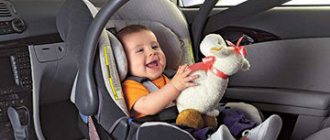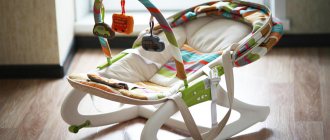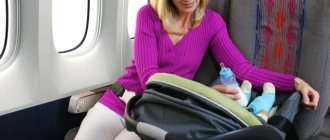History of walkers
The history of baby walkers goes back a long way. It is difficult to name the exact date of creation of this device. But the first mentions of walkers are found in works of art of the 15th century. Hieronymous Bosch's painting Christ Child with a Walking Frame, created in 1480, depicts a baby leaning on a three-legged device on wheels. The canvas of this artist hangs in Vienna, in the Kunsthistorisches Museum. Since then, walkers have undergone many transformations and changes, but the purpose of the device - to be a support for the baby when taking the first steps - remains the same.
Contraindications
There are a number of contraindications to the use of walkers:
- rickets;
- high tone of leg muscles;
- the child’s inability to sit independently;
- lack of skill in standing for long periods of time;
- dysfunction of the musculoskeletal system;
- hip dysplasia;
- mental disorders;
- developmental disorders;
- Congenital heart defect;
- cerebral palsy.
It is worth paying attention to how the baby himself reacts to the device that is new to him. They are often equipped with developmental complexes to improve fine motor skills and various sound effects, which the baby himself does not always like. If for some reason a child refuses to sit in a walker, cries, or is frightened by loud music or a bright picture, you should immediately stop using them.
Prolonged psychological discomfort has a negative impact on the baby’s psyche, which can lead to apathy and even developmental delays.
Pros and cons of walkers
Baby walkers are still popular these days. Nowadays, almost no family with a small child can do without them. In the first months of a child's life, a walker will be a good gift. And parents are looking forward to trying out the device in action.
But when using walkers for children at an early age, parents can unknowingly harm the baby. Walkers place a strong vertical load on the child's spine and muscles - perhaps this is the main disadvantage of walkers for children. And if the muscles are not yet strong, this can negatively affect the child’s health. First, the baby must learn to sit, crawl, and thereby train the muscles and spine. If the muscles are not sufficiently strong during upright walking, the load on them increases.
But you shouldn’t completely abandon baby walkers. A few minutes of walking a day won't hurt. You just need to observe the child and his condition, whether he gets tired from walking.
It is believed that when wearing a walker, the baby begins to walk faster. But this fact has not been confirmed or disputed. After all, each child develops individually. And it can be quite difficult to say what exactly influenced his ability to walk.
But after using a walker, a baby may develop a fear of walking independently, without support. Therefore, if the child suddenly has a desire to “walk around”, it is better to simply support him while walking around the house. But don't overdo it. Remember: everything should be in moderation and on time.
After being in a walker for a long time, the baby may never learn to crawl. And this is also not good for him. After all, crawling improves the neural connections in the brain necessary for the child’s further development. If there is a lack of crawling, there will be no development of neural connections. And, of course, we should not forget about the benefits of crawling for strengthening the muscular system of the back, and in the future - for the correct formation of the biological mechanism of walking.
In addition, remember that in a walker the baby moves by pushing his legs off the floor. Because of this, the child may develop the incorrect ability to place his foot on the floor. Often, babies who often run around in walkers first begin to walk on their toes (on tiptoes).
The advantage of using walkers is that the world opens up much wider for little girls and boys. This has a positive effect on the child’s emotional state (he is interested, he is happy) and broadens his horizons.
Walkers for children: pros and cons
An undoubted advantage of walkers is the ability to provide the child with relative independence, thanks to which he can actively explore the world around him, while giving parents a little respite. In addition, thanks to the walker, the child can maintain his body in an upright position for a long time. Thanks to this, the baby’s more active emotional development is stimulated.
But despite such pleasant positive aspects, the potential harm that walkers can cause to a child should also be taken into account. This is possible in a situation where the device is used either incorrectly or too often. So, the possible consequences:
- if you use a walker too early, you can deprive the child of an important stage of his development - learning about the world around him by crawling;
- for the same reason, disturbances in the structure of the skeletal system are possible;
- if a walker is used for an excessively long time during the day, the child will gradually begin to develop flat feet, dislocation of the hip joint, etc. This is due to the fact that when moving in a walker, the child relies mainly on the front part of the foot;
- There is a tendency to slow down the onset of independent walking in babies who spend too much time in walkers.
When to put your baby in a walker
Some parents put their baby in a walker as early as possible, believing that this will help the child quickly learn to walk. Other mothers and fathers are in no hurry with this, arguing their choice by the fact that each stage of the baby’s skills has its time, and there is no need to rush to get ahead of it.
So at what age should you put your child in a walker? What are the benefits of walkers? And does the baby need them? Pediatrician, Candidate of Medical Sciences, author of popular books and television programs about the health and development of children, Dr. Evgeniy Komarovsky, believes that the use of walkers is not the need of the child, but of the mother and father. Walkers are “useful” for parents because they can temporarily “neutralize” the baby while the mother gets things done, a doctor says. He is of the opinion that there is no need to rush with walkers. Before the baby reaches nine months, Evgeniy Komarovsky categorically does not recommend using walkers. Until this time, it is best to replace them by keeping the baby in a playpen, where he can crawl, sit, and even stand if he needs it.
On average, the age when a child can be placed in a walker is 7-8 months (if we are talking about a baby born on time). If the child was born ahead of schedule (premature), add as many weeks to the age as the birth was earlier.
Reaching 7-8 months is considered a suitable age for walkers, because at this time children confidently hold their heads, can sit without support and stand near support. And this, in turn, indicates the maturation of the musculoskeletal system and readiness for upright walking.
But parents should know that even at 7-8 months, the baby’s spine and muscles are not yet ready for long-term stress, which is walking. In addition, sitting in one position in a walker, the body weight is distributed on the pelvic bones and spine. Due to incomplete support on the foot, the baby may develop pathological curves of the spine or develop displacement of the vertebrae. Therefore, if you decide to use a walker, do not keep your baby in it for a long time. Be sure to take breaks and do not put too much stress on your child.
Which walker to choose
Parents, when purchasing baby walkers, must remember that the child, while in them, will encounter obstacles, and perhaps even get stuck in narrow corridors, so one should not lose vigilance and purchase only those devices that will be safe for the baby. In this case, it is necessary to ensure that the floor in the places where the walker moves is level.
Walkers can be folding or solid. Folding ones must have rigid latches that can withstand the speed of movement and the weight of the child. You can take these walkers with you on a trip to the country, but you need to be very careful to prevent injury to the child. Children who have barely learned to walk need special supervision; they are provided with training walkers in the form of trolleys. Children move after the walkers, holding their handles.
What should be on a walker
Walkers vary in the number of wheels - the best ones are those with 6-8 removable, silent silicone wheels. These wheels are easy to clean and wash. The walker must have a movement lock. The seat in a walker can be on a hard or soft frame. The child should sit in it in such a way that the upper level of the seat is at the level of the baby’s chest. The seat back should be rigid so as not to harm the child's spine.
Walkers can be multi-purpose - transform into a bicycle, a feeding table, or a children's swing. Fabric covers should be easy to remove so that they can be cleaned or washed at any time.
Safety precautions when using walkers
Do not leave your baby in a walker without adult supervision. A child at this age has poor balance and may fall out of the walker. And don’t forget: an unattended child in a walker is at risk even in an apartment.
When your child gets into the walker, close the cabinets so that he cannot open the cabinets and bedside tables. Hide breakable objects higher up so he can't reach them. Close sockets with special plugs.
Limit your baby's movement so that he does not go onto the stairs or into the street. Make sure that the child does not fall on the thresholds.
How to choose and how much do they cost?
Choosing quality walkers is not difficult. The main thing when choosing is to pay attention to the following criteria:
- Material. Choose thick plastic. Too thin plastic easily cracks and bursts upon impact.
- The width of the frame should be one and a half times wider than the seat.
- Wheel size. Larger wheels are safer.
- Seat design. Choose models with a rigid back to support the spine. The holes for the legs should be soft to prevent chafing of the skin.
- Height adjustment.
Note! When choosing, give preference to proven global brands. It is worth paying attention to the pricing policy. Too cheap models are made of low-quality plastic, which can cause intoxication in the baby.
Table: best three models.
| Name | Advantages and disadvantages | Price |
| "Baby Care Prix SB-806" | Pros: • Sustainability. • Height adjustment – 3 levels. • Game panel. • Removable upholstery. • There is a stopper. Minuses: • There is no sound adjustment on the game bar. It harms your hearing. | 2,800 rubles |
| "Chicco DJ Baby Walker" | Pros: • Game panel. • Removable seat. Minuses: • Wheels are widely spaced. | 7,500 rubles |
| "Capella Bg-0619" | Pros: • Height adjustment – 5 levels. • Removable game panel and upholstery. • Easy to fold. Minuses: • Plastic with a specific odor is used for production. | 3,300 rubles |
Myths
Marketing Myths:
- Walking training.
Yes, with the help of this attribute you can teach walking, but you should take into account the shift in the center of gravity and as soon as the baby stands on his own legs, he will lose his balance. This applies to children from 9 to 12 months. After a year, children tend to stomp their feet on their own. - Strengthening muscles. It's a delusion. You can strengthen your muscles by walking or crawling.
- Fall protection. Children's transport for movement deprives the baby of the feeling of danger and falling. And this is a mandatory skill for a child. He must learn to fall, group his muscles, and protect himself from blows for self-preservation.
Contraindications for use
It is strictly forbidden to place your baby in such vehicles in the following situations:
- The baby sits unsteadily, staggers or falls over on its side.
- The child has increased or decreased muscle tone.
- The baby is sick with rickets.
- The baby has problems with the musculoskeletal system.
Useful video
Share this post
- Related Posts
- Crafts for March 8 from cotton pads for children
- How to conceive a girl by 100% ovulation: methods and tips
- How to properly wash a newborn under the tap: a boy and a girl?
- How many continents and continents are there on earth?
- How to properly sew an envelope for a newborn’s discharge with your own hands?
- Norm of weight gain in newborns by month: table











